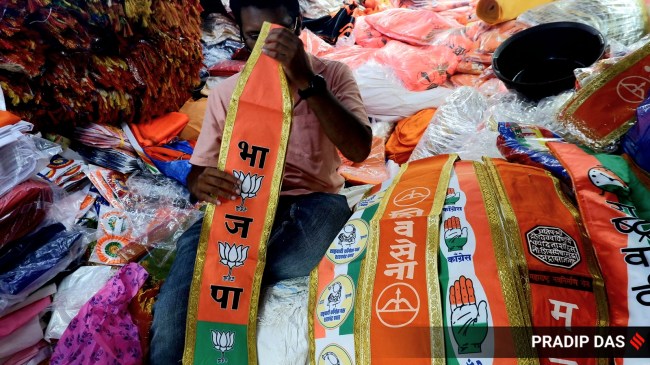Opinion From ‘Islamophobia’ to defence spending, Pakistan’s view on India’s election
The shift towards autocracy, a worrying arms build-up and the conflicts with Pakistan signal a dark age for India
 A shopkeeper in Mumbai with material showcasing different political parties' symbols, ahead of the upcoming Lok Sabha elections. (Express photo by Pradip Das)
A shopkeeper in Mumbai with material showcasing different political parties' symbols, ahead of the upcoming Lok Sabha elections. (Express photo by Pradip Das) At stake in India
With the general elections looming in India, the media in Pakistan has commented on India’s “misadventures” in Pakistan, its “disproportionately-high spending” to bolster the military capabilities and its shift towards “autocracy”.
News International (April 6) says, “India’s misadventures in Pakistan are often seen by critics as the country’s ruling party’s attempt to keep its support base… since it provides a thriving market for consumer goods and can help the West curtail China’s growing dominance, the Western world is exercising caution and preferring not to condemn India for its violations. But India is overstepping its boundaries.”
Express Tribune (April 5) comments on the worrying arms build-up saying, “It would be one thing if India was quiet and methodical — building up a strong defence without threatening anyone. Unfortunately, Prime Minister Narendra Modi’s decade in charge has been quite the opposite.”
The Nation (April 1) notes the misuse of law enforcement agencies, the acquisition of NDTV by Gautam Adani, the blanket bans on coverage of Kashmir and the “constant news cycles of minorities in India being lynched by mobs or being subject to acts of Islamophobia” with the Ram mandir-Babri masjid example.
Keeping this cycle of repression and oppression in mind, the editorial concludes by saying, “Suppose this electoral outcome is really as inevitable in reality as it is in perception. In that case, we may be on the cusp of witnessing an India is more prone to religious extremism and autocratic principles than ever before – a truly heart-wrenching moment in the nation’s history.”
Where are the women in the judiciary?
Recently, a report by the Law and Justice Commission of Pakistan found that the representation of female judges among the highest courts in Pakistan is an abysmal 5.5 per cent. This means that out of the 126 judges at the Supreme Court, Federal Shariat Court and the five high courts, there are only seven female judges.
Dawn (April 3) speaks to the need for wider representation in the Court saying, “Women bring unique insights to the bench, essential for addressing gender-specific issues and ensuring a more equitable dispensation of justice. Their presence is not only a matter of representation; it is a prerequisite for fostering a judiciary that reflects the values of fairness and equality.”
The Nation (March 31), too, laments the underrepresentation of women in the judiciary and suggests “the establishment of mentorship programs for women in the legal profession” to ensure “equal opportunities for career advancement”.
A disappointing World Bank prognosis
Earlier this week, the World Bank declared that Pakistan’s growth for this fiscal year will be slightly higher after it shrunk by 0.2 per cent last year. Even so, it is not expected to go above three per cent for the next two years. The media believes that while an economic crisis has largely been averted in the short term, there has to be an “articulation of an unambiguous policy direction… and deep structural reforms” to bring the economy back on track.
Express Tribune (April 4) says, “the biggest problems are still massive government debt, low revenue and inefficiency… The hope was that a strong new government could have changed this precedent, but voters had different priorities.” Moreover, with poverty having risen by 4.5 per cent and millions more falling below the poverty line, policymakers “can’t risk letting inflation rise again, especially when the working poor continue dropping into poverty.”
Dawn (April 4) reiterates that “Pakistan’s options are few at this point… the only way forward is to implement broad-based reforms on a sustainable basis.”
Joe Biden writes to Shehbaz Sharif
US President Joe Biden’s first letter to Prime Minister Shehbaz Sharif signals a thaw in the relationship between the two countries. It is believed that after the cipher controversy during Pakistan’s ex-prime minister Imran Khan’s term, “relations had gone cold” (News International, April 3). But in this letter, Biden has promised to stand by Pakistan and maintain a partnership to overcome regional and global security challenges.
Nonetheless, Daily Times (April 6) warns the government to “tread with caution”. It says, “Pak-US ties should be rebuilt with an emphasis on the issues concerning the two countries… Trying to involve the Afghan equation or expecting Washington to choose us over India, a trailblazing superpower, would be a gross mistake.”
News International (April 3) brings in the China hurdle and says that while “Biden underscored shared priorities in areas such as public health, economic development, and education, affirming a commitment to advancing together… many experts believe that the real test will be Pak-China relations as it is no secret that when it comes to CPEC, the US has its reservations because of China’s growing influence in South Asia. These reservations are not going anywhere.”
adya.goyal@expressindia.com






